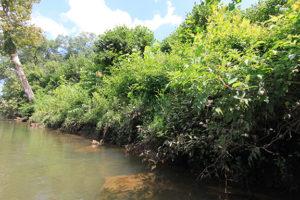
Having property along a creek or river seems like an appealing proposition. However, one of the challenges that property owners often face, whether it be residential or any other type of property, is dealing with streambank erosion along the creek or river. There are many inherent factors involved with streambank erosion, but one of the primary contributors is urbanization which increases the amount in impervious surfaces (roadways, parking lots, roofs, etc.) within the watershed. This change in land use results in an increase in stormwater runoff which is moving into our creeks and rivers. This upsurge in volume magnifies the sheer stress along the streambank which results in soil erosion that can lead to wholesale streambank failure. This process is often exacerbated when the erosion undermines adjacent trees which fall into the waterway and block the natural flow of the water. In some cases, if left unchecked, the streambank erosion will dramatically affect the loss of property, and also create hazardous conditions which can impact structures and infrastructure. All of these conditions can substantially decrease the overall property values for the property owner.

There are a multitude of ways to address streambank erosion. Regardless of the method chosen it is important that it appropriately addresses the overall dynamics with the channel including pattern, dimension and profile. In some cases, the use of hard armoring, such as the placement of large rip-rap stone, is the only effective method for addressing the streambank erosion. However, this method creates somewhat of a “scar” on the landscape as it does not provide the ecological benefits of replacing the loss of the degraded vegetation from the overall stream habitat. The preferred method, to stabilize and mitigate streambank failure, is a soil bio-engineering technique referred to as Vegetation Reinforced Soil System (VRSS) utilizing soil encapsulated, earthen lifts. It is nearly impossible to simply place soil material onto a steeply eroded streambank and expect it to remain stable. The VRSS system, properly executed, provides an option to rebuild the eroded streambank in such a manner so that natural riparian buffer vegetation can flourish, which adds a critical component to the long term stability of the project.
The execution of a VRSS system starts with the placement of rip-rap stone as the foundation for the soil encapsulated lifts. This rock is trenched in at a minimum depth of 18″ below channel grade to anchor it in place and is extended 1.5-3 feet above the normal low water mark to account for water fluctuations. Following the placement of the rock foundation, a series of compacted soil lifts are placed in 12-18 inch increments to match the grade at the top of the slope. Several layers of geotextile fabrics as well as geogrid material (similar to that used in retaining walls) are used to “encapsulate” each lift to “hold” the compacted soil in place. Batter boards are utilized as a temporary measure with each lift to facilitate the soil compaction process. The outer covering of each lift is a coir erosion control matting which is comprised of a natural fiber extracted from coconut husks. This matting is designed to stay resilient for a period of three to four years, but ultimately will biodegrade and become incorporated in the streambank. In between each soil lift, composted soil material is placed to provide a growing media for the successful establishment of native riparian buffer vegetation. This vegetation component can be installed as nursery grown material or as cuttings of native plants which have the ability to root and grow as live stakes such as Black Willow or Silky Dogwood. Ultimately after two or three years of growth, the planted and also volunteer vegetation, “hides” the fact that Mother Nature had some help in protecting the creek or river bank from further erosion and reestablishing a stable stream habitat.
It is important point to note that, in the State of Georgia, any project involving land disturbing activities within the protected creek, stream, or river buffer requires Local, State and Federal approval before any work can be initiated. In addition to the implementation of streambank stabilization projects, Aquascape Environmental has in depth experience in providing turnkey services in the development of the required design and erosion control plans to meet the regulatory requirements.



